



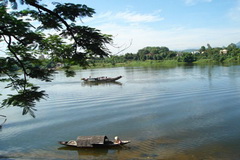
La rivière des Parfums (Sông Hương) tire son nom des nombreuses herbes médicinales qui poussaient sur ses rives. Nombreux villages de sampans avec leurs petits autels et les offrandes sur le toit, à l’intention des génies de l’eau. La...
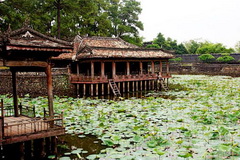
Le tombeau de Tu Duc est construit dans une vallée étroite appartenant au village de Duong Xuan Thuong (aujourd’hui, c’est le hameau de Thuong Ba, village de Thuy Xuan). Le tombeau est situé au milieu d’une immense forêt de pins, à 8 km du...
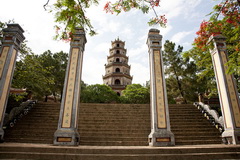
La pagode de la Dame céleste (en vietnamien: Chùa Thiên Mụ) est la pagode la plus haute du Viêt Nam avec les six étages supérieurs de sa tour, dénommée « Source de félicité ». Elle se trouve à Hué sur...

The tomb of Gia Long is in fact a group of tombs including those of the Emperor's relatives. The whole compound is spread on a joint mountain with 42 small and big mounts, amongst which Dai Thien Tho is the biggest.To visit Gia Long's tomb, tourists can go by boat about 18km along...
.jpg)
Établie comme capitale du Viet Nam unifié en 1802, la ville de Huê a été non seulement le centre politique mais aussi le centre culturel et religieux sous la dynastie Nguyên, jusqu'en 1945. La rivière des Parfums serpente à travers la...
.jpg)
Pagoda was built in the shape of the Chinese character "Khau" (mouth), with the main building consisting of three rooms and two wings. It faces the southeast and uses Ngu Binh Mount as a front screen.The pagoda was originally a small hut built by Nhat Dinh in 1843, who was formerly recognized by...
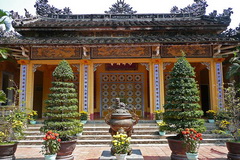
The pagoda includes a main sanctuary with two statues of the Deity Eight Vajra.Dieu De Pagoda was built by King Thieu Tri in 1844 on the platform of 5,000m² in his old residence, where he was born in 1807. It was constructed on a large scale, but was badly damaged during the successive wars....
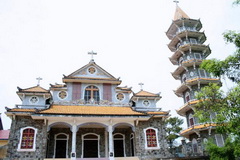
The Hermitage Bien Duc Thien An, usually name Thien Duc Hermitage, has been founded in Summer 1940 by the Bien Duc French hermits with the name of Thien An (Peace from Heaven).The hermitage is formerly managed as an infirmary and a school. To day the hermitage is only a place for religious...
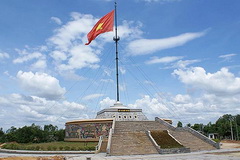
It is commonly known as a flagpole, but viewed from the Imperial City; it is really a huge structure of three flat-top pyramids, one lying on top of another. It was built during Emperor Gia Long's reign, in 1807, and later improved by his son, Emperor Minh Mang.According to the Thuc Luc...

De tous les tombeaux impériaux qui jalonnent la rivière des Parfums, le mausolée de l’empereur Khai Dinh, l’avant-dernier souverain de la dynastie des Nguyên (1802-1945), est le plus étonnant, son architecture étant totalement différente...

Soyez le premier à connaître nos offres de voyage exclusives et les nouveaux circuits !.